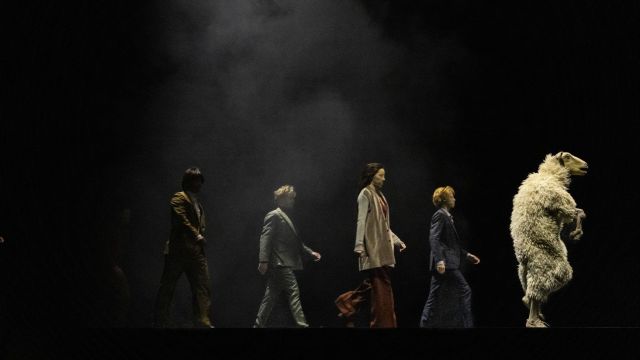The Sheep Song
Unlike Snowball's condensation of the Seven Commandments of Animalism “Four legs, good, two legs bad” in George Orwell’s satirical, allegorical novel Animal Farm, the main character in The Sheep Song believes that two legs will fulfil all of his dreams.
This breath-taking theatrical experience begins with a giant bell suspended above the audience, being tolled by a naked man draped in red. We meet our protagonist, a sheep, who is grazing peacefully among a flock of real sheep (no mean feat to wrangle on a huge stage). But he is restless, unhappy with his lot and he struggles to stand on his hind legs and walk upright.
This is a long sequence, but justifiably so as it sets the tone for the rest of the performance.
The sheep hesitantly joins the human world, and we follow his trials, tribulations and many strange encounters in his brave new world.

After a making a Faustian bargain with the bellringer, he gradually becomes more humanized, developing human arms and wearing a jacket.
Using a series of rarely static conveyor belts he travels through a series of fascinating and moving tableaux that travel backwards and forewords across the stage and time as our part-animal, part-human creature finds on his road a bizarre collection of flamboyant characters, until his adventures turn tragic.
FC Bergman creates an allegorical epic without the use of dialogue, drawing from the Flemish Primitives, from the beauty of the language of bodies, and from the emotions of bestiaries. The Antwerp collective gives us a modern fable which borrows its narrative from medieval morality.
Our friend finally and sadly realises that you are what you are and, in his case, that four legs are good and two legs are bad – but is there way back?
This unique animal reminds us of ourselves as it torn as it is between the fear of change and the desire to transcend limits.
What I love about The Sheep Song is that it is approachable from many angles, the allegorical, the philosophical and the spectacle.

Bergman is the master of creating images that live in the mind; the ominous bell rung by a naked draped bellringer, the clattering of sheep’s trotters and occasional bleat, the birth of the sheep’s baby, the seemingly endless procession of faceless people, the ‘evolution’ of the sheep into a humanoid and the sheep’s eventual return to the flock.
The stagecraft required to present spectacle this is immense – the wrangling of live sheep onstage, the large number of props to place on the conveyor belts, the difficulty of working in the sheep costume, all cast working in face coverings and working in dramatic contrasts of lighting.
There are moments of painful silence scattered between banjo/mandolin solos which form the only musical accompaniment.
Titus De Voogdt is to be commended on a bravura performance as the title character. He is onstage the whole performance in a costume with limited visibility and shoes which force him to walk on the front part of his feet. Even though his sheep’s head has no expression (a wise decision as this implies innocence), his physical acting more than makes up for this.

Our friend finally realises that you are what you are and, in his case, that four legs are good and two legs are bad – but he can now no longer live in either world.
The Sheep Song is a glimpse into the mind of a theatrical visionary and a reminder that even though our lot seems unjust, the alternative may not be what we imagine!
Barry Hill OAM
Photographer: Tim Standing, Daylight Breaks
Subscribe to our E-Newsletter, buy our latest print edition or find a Performing Arts book at Book Nook.

